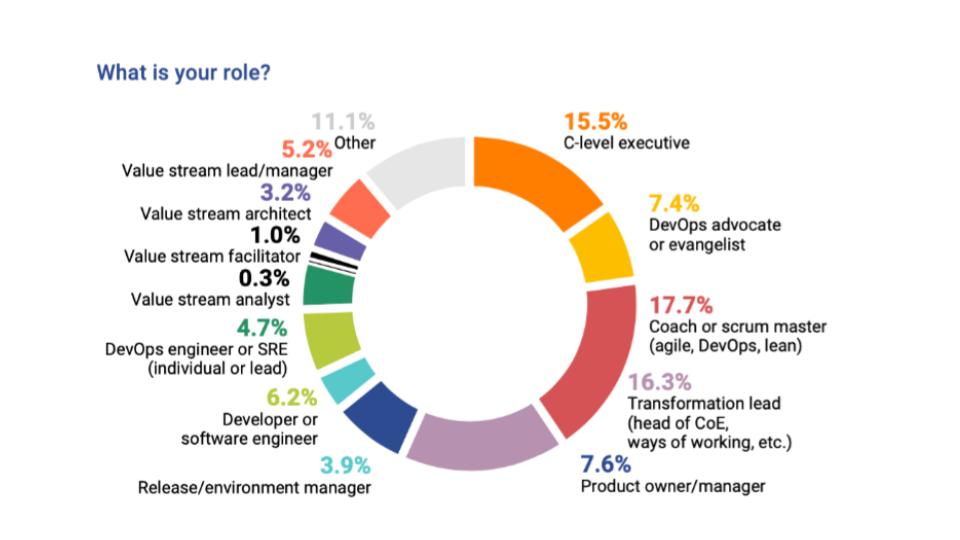In our inaugural State of Value Stream Management Report, published in July 2021, 10% of respondents reported being in a role that has “value stream” in the title:
- Value stream lead or manager (5.2%)
- Value stream facilitator (1.0%)
- Value stream architect (3.2%)
- Value stream analyst (0.3%)
A further 11% reported their role as “Other”. These respondents identified as business and user experience analysts, project management and, most interestingly, from a VSM perspective, a value consultant and a release train engineer (RTE).
In this blog post, we take a closer look at the question: What is a Value Stream Architect?

Why do value streams need an architect?
We’ve always had people concerned about the value, cost, and quality of a software delivery product, but no one whose chief concern was the speed of software delivery.
As a result, the driver for removing waste was primarily cost and not speed. Efforts to improve speed were often focused on specific segments of a value stream (Agile teams, release pipelines) but not on the end-to-end process from idea to business outcome.
The Value Stream Architect role was therefore introduced to make changes to people, process, and technology that accelerate the flow of business value to customers.
Unlike a Value Stream Manager, who must know which things will add value to the customer, a Value Stream Architect need not be a product expert. Their focus is on enabling faster feedback loops that will improve decision-making at all levels, and as a result, business outcomes.
The differentiation here aligns with the VSMC’s identification of the duality of VSM’s goals:
- Flow - the primary concern of the VS Architect
- Value Realization - the primary concern of the VS Manager
What does a Value Stream Architect do?
In our Value Stream Management Foundation course, we established the architect role as a critical coordinator role, as per the table below:
|
Champion |
Coordinators |
Contributors |
|
High-level organizational leadership whose support facilitates change |
Mid-level leadership with cross-organization needs and responsibilities |
Direct participants in value creation and delivery activities |
|
|
|
A Value Stream Architect:
- Helps leadership organize teams around communication lines and application architecture for speed of delivery and flow (i.e., value streams)
- Helps leadership identify and prioritize investments for systemic improvement across intersecting value stream networks (e.g. product and process dependencies, platform modernization)
- Helps value streams identify their delivery constraints and prioritize continuous improvement work items in their backlogs
- Helps product owners ensure a healthy distribution of work across value delivery and value protection (e.g. security, compliance, and tech debt)
- Influences the creation of an integrated delivery pipeline and drives enterprise-level decisions about platforms and tooling
- Identifies training and skill development opportunities
In large-scale enterprises, one can imagine two levels of Value Stream Architects; an Enterprise Value Stream Architect that operates at the macro level to solve enterprise-level constraints and Product/Portfolio Value Stream Architects that work with product teams to drive flow and feedback.
Tenets of the Value Stream Architect Role
In his paper, Value Stream Architecture, published by IT Revolution, Dr. Mik Kersten sets out the tenets for VSA:
|
Software Architecture |
The VSA will impact the software architecture discipline of an application to be centered around flow. For example, APIs are created when they enable the creation of more features by a team or product line (e.g., increase business value flow for that line). |
|
Training |
The VSA will help identify what training programs are to be made available to teams and also identify role changes that will be required. For example, if a new code review tool is deployed, the VSA’s perspective is to ensure that enough senior engineers are assigned to prevent a bottleneck on code review. |
|
Tooling |
While tool selection continues to involve numerous stakeholders, all production tools must be connected to the flow defined by the VSA. For example, a new build tool can be experimented with but will not be standardized until it is proven to integrate with upstream and downstream tools. |
|
Reporting |
An optimized reporting model for VSAs is one that allows for VSAs to report into the LOB to get visibility into what is happening at the ground level, similar to a manufacturing floor view, as well as have some VSAs report directly to the CIO to aggregate changes to tooling and platforms that need to be influenced across the LOBs. |
|
Organizational Structure |
The organizational structure must be aligned to the desired value stream architecture. For example, the organization may need to break down execution teams into squads or product organization so as to be self-sufficient in optimizing the value stream for the success of the LOB. |
|
Risk Assessment |
A core part of the VSA will be to ensure compliance and automate risk assessment. For example, if a new static analysis code review tool is deployed, the reporting capabilities make visible all teams that are not yet using the tool. |
|
Transformation Teams |
The VSA model will influence the organization to establish a transformation team to implement and support tools/platforms that can be cross-leveraged across LOBs. This will ensure that the LOBs backlog is not impacted with solving for value stream optimization but can instead focus on delivering business value. |
What a Value Stream Architect Says About His Job
In DevOps Institute’s Ask Me Anything with Value Stream Architect Bryan Finster, he said:
“I think the key metric for a Value Stream Manager should be: “Is this value stream creating, saving, or protecting money?” For a Value Stream Architect, the metrics are focused on waste in the system. Removing waste improves the ability to deliver value.”
Are you a Value Stream Architect? What's important for you?

Naomi Lurie
Naomi Lurie is VP of Product Marketing at Planview. She is passionate about making businesses successful through effective customer-centric communication.









Comments 0